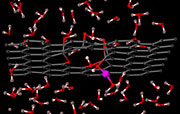- Number 435 |
- March 23, 2015
-
PPPL researchers find 3-D printed parts provide low-cost, custom alternatives for lab equipment
"The printer is now a crucial piece of our laboratory and used regularly," said Andrew Zwicker, the head of Science Education at PPPL and lead author of a paper that reports the results in the American Journal of Physics. "The versatility of the printer is such that our first reaction to an equipment need is no longer whether we can find or purchase the required piece of equipment, but can we print it?"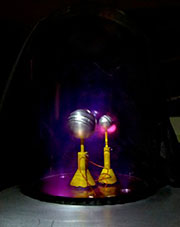 The 3-D printing scene, a growing favorite of do-it-yourselfers, has spread to the study of plasma physics. With a series of experiments, researchers at the DOE's Princeton Plasma Physics Laboratory (PPPL) have found that 3-D printers can be an important tool in laboratory environments.
The 3-D printing scene, a growing favorite of do-it-yourselfers, has spread to the study of plasma physics. With a series of experiments, researchers at the DOE's Princeton Plasma Physics Laboratory (PPPL) have found that 3-D printers can be an important tool in laboratory environments.
Three-dimensional printers create objects by laying down layers of material, whether plastic, metal, ceramic or organic. A computer controls a moveable nozzle that extrudes the hot material according to digital computer-aided design (CAD) files. Each layer is thin, often measuring only several hundred millionths of a meter in height. -
Monitoring the invisible: New technology for nuclear detection
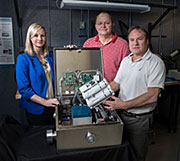 A new device created by researchers at the Savannah River National Laboratory (SRNL) and Oak Ridge National Laboratory is able to immediately collect airborne particles to help determine if radioactive isotopes are present. This device could prove to be a valuable asset to organizations responsible for monitoring nuclear activities worldwide.
A new device created by researchers at the Savannah River National Laboratory (SRNL) and Oak Ridge National Laboratory is able to immediately collect airborne particles to help determine if radioactive isotopes are present. This device could prove to be a valuable asset to organizations responsible for monitoring nuclear activities worldwide.
The Tamper Resistant/Tamper Indicating Aerosol Containment Extractor (TRI-ACE) is about the size of a small cooler and can collect particles such as plutonium, uranium , and other nuclear material in the air before it is able to settle on a surface. It’s also able to clearly demonstrate if anyone tries to interfere with the sampling. The TRI-ACE offers constant, unattended collection, flags abnormalities, and collects material that may be used to indicate if illegal nuclear activities have taken place at a facility. -
New process recycles valuable rare earth metals from old electronics
“Recycling rare-earth metals out of consumer waste is problematic, and there are multiple obstacles in the entire chain from manufacturing to collection infrastructure to sorting and processing,” said CMI and Ames Laboratory scientist Ryan Ott. “We’re looking at ways to make the processing part of that chain—removing the rare-earths from scrap magnet material—better."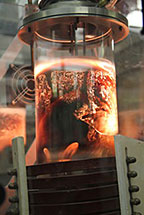 Scientists at the Critical Materials Institute at DOE's Ames Laboratory have developed a two-step recovery process that makes recycling rare-earth metals easier and more cost-effective.
Scientists at the Critical Materials Institute at DOE's Ames Laboratory have developed a two-step recovery process that makes recycling rare-earth metals easier and more cost-effective.
Building upon previous research work done at the Ames Laboratory, Ott and his research group have developed a two-stage liquid metal extraction process that uses differences between the solubility properties of different elements to separate out rare-earth metals. -
Quest for efficiency in thermoelectric nanowires
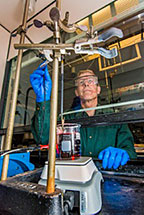 Efficiency is big in the tiny world of thermoelectric nanowires.
Efficiency is big in the tiny world of thermoelectric nanowires.
Researchers at DOE's Sandia National Laboratories say better materials and manufacturing techniques for the nanowires could allow carmakers to harvest power from the heat wasted by exhaust systems or lead to more efficient devices to cool computer chips.
Sandia researchers published a paper, “Using Galvanostatic Electroforming of Bi1-xSbx Nanowires to Control Composition, Crystallinity and Orientation,” in the Jan. 28 edition of the Materials Research Society’s MRS Bulletin. The authors are W. Graham Yelton, Steven J. Limmer, Douglas L. Medlin, Michael P. Siegal, Michelle Hekmaty, Jessica L. Lensch-Falk, Kristopher Erickson and Jamin Pillars.

